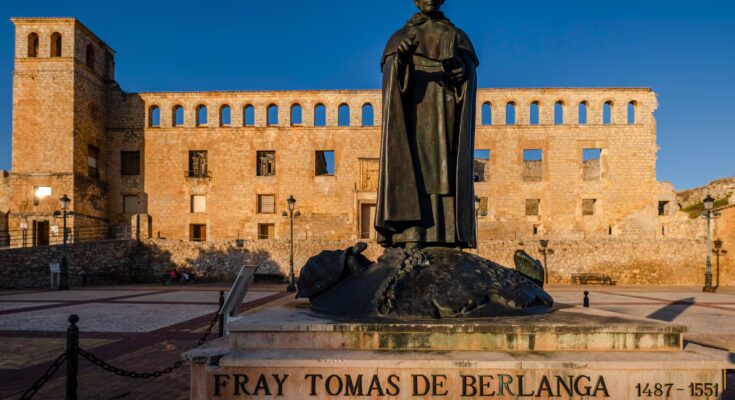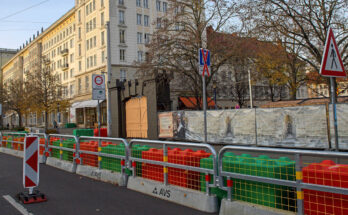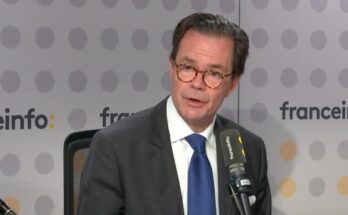The considered father of the Mediterranean diet, whose international day is celebrated on November 13, was an inhabitant of Soria. The person who accidentally arrived at the Galapagos Islands in 1535, which would be the basis for Charles Darwin’s theories of evolution, was a gentleman from Soria. The originator of a step to improve communications on the American continent and predecessor of what would later become the Panama Canal was a gentleman from Soria. The same in all three milestones. That gentleman from Soria was Fray Tomás de Berlanga (Berlanga de Duero, Soria, 1487 – ibidem 1551), a religious man of the Renaissance when the Renaissance did not even figure in the cultural calendar of the time. This Dominican friar born in Berlanga de Duero (Soria, currently 830 inhabitants) was destined for the new continent and there he ended up being bishop of Panama, as well as a restless thinker. With his innovations in the garden, he promoted a varied gastronomy and came to be considered the patron of the Mediterranean diet, declared an Intangible Heritage of Humanity in 2010, which includes Spain, Italy, Greece and Morocco.
The gastronomic legacy of Fray Tomás de Berlanga is based on some keys now carved in stone on the tables of healthy eating, which distinguish Mediterranean cuisines from the barbaric ones of the north, but which then lacked that recognition. Olive oil, abundance of plant foods with legumes and seasonal vegetables and fruit, regular consumption of bread and cereals, defense of fresh products, intake of dairy products and reduction of red meat. Today they are practically evident, but if they have achieved this status it is thanks to the impulse of the Dominican, inspired by his stays in America and his horticultural studies and work, whose teachings he spread in his congregations. The researcher Ignacio Jáuregi-Lobera, from the Institute of Behavioral Sciences of the Pablo de Olavide University of Seville, studied the figure of this versatile friar in an article entitled Galapagos Islands, theory of evolution, Panama Canal and Mediterranean diet: Fray Tomás de Berlanga.
The analysis recalls Tomás Martínez, or perhaps Enríquez?, since it is not clear, and with the second surname Gómez. The man from Soriano is remembered today in his town, where he rests eternally, with a statue at whose feet there are a turtle and an alligator to remember his exotic adventures. Another evocation is found in the collegiate church of Santa María del Mercado de Berlanga de Duero, where this great man was buried, in the form of a saurian: the one known as the Berlanga lizard, about four meters long. Legend has it that, upon his return from America, good old Tomás decided to bring a live alligator with him to show it in Castile and demonstrate his expeditions. Once the beast was dead, it was stuffed and hung on one of the walls of the temple so that no one would doubt the cleric’s travels.
The religious education of this historical figure took him from Berlanga to El Burgo de Osma, also in Soria, before moving to a Dominican convent in Salamanca and ending up enlisting in the crews headed to the New World, where he served as protector of the indigenous people. Thomas embarked in 1510 soon to be elected prior of the Dominican convent of Santo Domingo. Then they appointed him vice provincial of their order in Mexico and, at the same time, Pope Clement VII, with the mediation of Emperor Charles I, appointed him bishop of Panama. His adventures took him to Lima, with clashes with Francisco Pizarro, and on those voyages he drew up precise nautical charts without being able to prevent the currents from depositing him in the virgin archipelago of the Galapagos on 10 March 1535. Just 300 years later, Charles Darwin landed on those islands, noticed the difference in the beaks of birds of the same species and understood that they evolved according to their environment, adapting to the environment. The friar also anticipated the subsequent Panama Canal (which began to be adapted in 1903) by developing a proposal to join the Atlantic Ocean with the Pacific, or vice versa, since there were only a few kilometers between the two.
The gastronomic aspect of Soriano was cultivated since his move to America. He brought to Santo Domingo the current Canarian banana, much smaller than the Central American banana, at the same time that he discovered the beauty and flavors of the tomato and was the first foreigner to begin planting it massively given the capabilities of the time. Subsequently, together with parsley and potatoes, he brought home the tomato seeds and plants so appreciated today in Europe. Likewise, he introduced key European knowledge and techniques to American territories to optimize local agriculture. These exchanges of products and knowledge between territories, and the way in which they took root in the gastronomic cultures of each of them, led him to be considered the father or patron of the famous Mediterranean diet, which draws from both worlds and was born in Soria.



